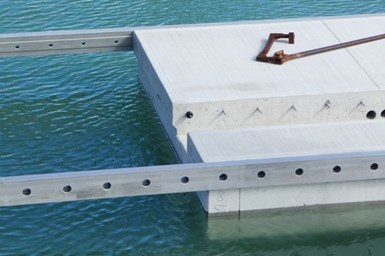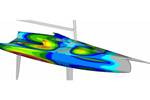Pultron Composites advances marina construction with innovative GFRP waler
The waler incorporates a GFRP thru-rod and nut system, delivering high flex and fatigue resistance and increased environmental and aesthetic longevity.

Composite waler at the Half Moon Bay Marina. Photo Credit, all images: Pultron Composites
Pultron Composites (Gisborne, New Zealand) has developed a composite waler in collaboration with marina design and construction specialist, Bellingham Marine (Wash., U.S.). Designed, engineered and manufactured under controlled conditions to meet strict ISO 9001:2015, ASTM and specific performance standards, the waler is currently incorporated at Half Moon Bay Marina in New Zealand.
A waler is a horizontal structural beam mounted to the side of the dock section. It spans multiple concrete floats, fastening them together. Walers play a critical structural role in marina, or harbor, construction. Pultron’s design attaches the waler to the floating dock by a glass fiber-reinforced polymer (GFRP) composite thru-rod and nut system, manufactured via the pultrusion process. These are long rods, threaded at each end, and held in place by a nut. The waler and thru-rod are said to be critical parts of Bellingham’s Unifloat Concrete Dock System.
While walers can be made of timber, aluminum or steel, these materials come with limitations. Timber, for example, doesn’t corrode like steel, but it does rot and has a shortened life cycle compared to composites. Alternately GFRP composites deliver several advantageous including elimination of corrosion, high tensile strength and light weight. High flex and fatigue resistance protects the waler against constant motion caused by tides, waves and boats. The video below shows that the composite waler will flex with the motion and return to its original shape without losing stiffness.
The composite waler also won’t impact the marine ecosystem around it, offers cost-competitive prices and excellent durability and maintains its aesthetics without the rust leakage marks or broken concrete caused by corroding steel.
A critical innovation in its design, Pultron says, was the keyway (a longitudinal slot cut into a component to accept a key) that locks into a matching detail on the floats. This customization maintains alignment between floats, while reducing shear stress on the bolts. Maintenance costs have also been reduced. As part of the Unifloat Concrete Dock System, the composite waler decreases the need for bolt retightening by working with the self-tightening thru-rod system. This reportedly lowers repair expenses and delivering an estimated service life of 75+ years.

GFRP waler under construction.
Other customized features involve a drilled hold on the outside, and a central cavity with a smaller drilled hole on the inner face, recessing the nuts for safety and avoiding boat damage. The waler’s flexural strength, ten times that of timber, provides high impact resistance and an even distribution of loads.
Pultron reports that the the next major project using this technology is the Dana Point Harbor in California, U.S. When completed, it is said it will be the first U.S. marina to be outfitted with composite thru-rods, composite walers and Mateenbar composite reinforcement throughout.
Related Content
-
Large-format 3D printing enables toolless, rapid production for AUVs
Dive Technologies started by 3D printing prototypes of its composite autonomous underwater vehicles, but AM became the solution for customizable, toolless production.
-
Manufacturing the MFFD thermoplastic composite fuselage
Demonstrator’s upper, lower shells and assembly prove materials and new processes for lighter, cheaper and more sustainable high-rate future aircraft.
-
Plant tour: Joby Aviation, Marina, Calif., U.S.
As the advanced air mobility market begins to take shape, market leader Joby Aviation works to industrialize composites manufacturing for its first-generation, composites-intensive, all-electric air taxi.
















